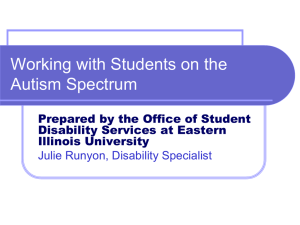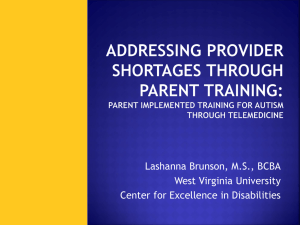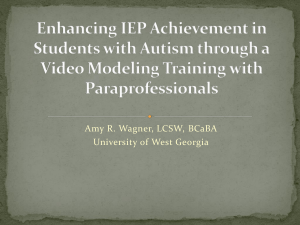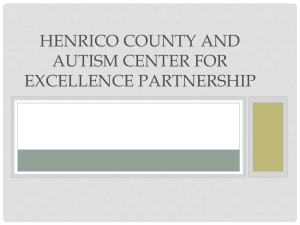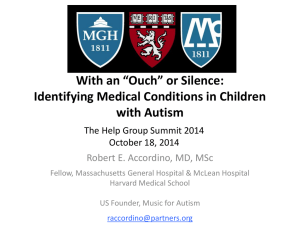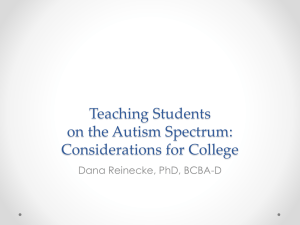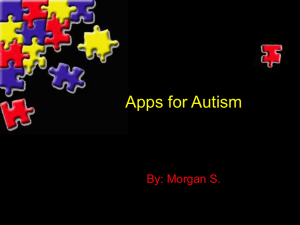TA PPT - uwradar
advertisement
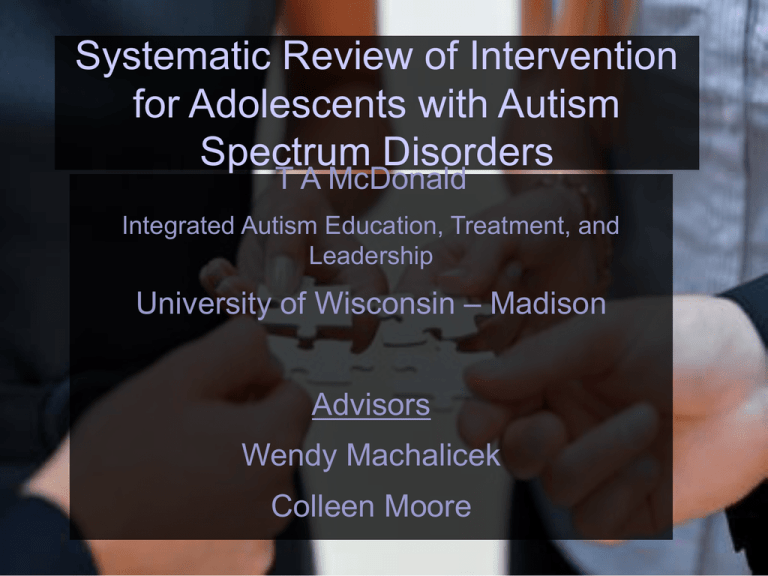
Systematic Review of Intervention for Adolescents with Autism Spectrum Disorders T A McDonald Integrated Autism Education, Treatment, and Leadership University of Wisconsin – Madison Advisors Wendy Machalicek Colleen Moore Background ➢ ➢ Early intervention ➢ Increase in type ➢ Increase in empirical designs Teen intervention ➢ Adaptations from child interventions ➢ Few tested with adolescents ➢ Many of these not empirical designs Implications for Adolescence ➢ Negative consequences “As students with autism spectrum disorder reach adolescence, the potential impact of inappropriate social behavior increases” (Graetz, Mastropieri, & Scruggs; 2009). ➢ Developmental Changes “...adolescence may be a particularly difficult time for higher functioning youth with ASD due to increasing anxiety and awareness of social difficulties” (White et al.; 2009). Implications for Adolescence ➢ Increased expectations with age “...since writing skills may affect later job performance, it is essential to identify effective writing interventions for this population” (Delano, 2007) “Among employment age adults with disabilities, some of the lowest employment rates are individuals on the autism spectrum” (Burke et al., 2010). Stakeholders ➢ Stakeholders ➢ ➢ Parents, teachers, clinicians, therapists, the adolescent with ASD Evidence Based Practice ➢ Does it work? ➢ Evidence with children ➢ ➢ Carry over to teen? Locating what works ➢ Individual articles, reviews? Articles and Reviews ➢ Organized around intervention ➢ Social Stories, Video Modeling, Functional Communication, Cognitive-Behavioral ➢ ➢ Many on ASD but mostly with children ➢ Will the tx generalize to adolescence? ➢ Mixed data of children and adolescents ➢ ➢ What about target concerns? Unable to determine outcomes for adolescents Many interventions for adolescents ➢ But not with ASD Current Study ➢ Review adolescent interventions ➢ Empirical designs ➢ ➢ ➢ ASD Identify target concerns Organize interventions around target concerns Methods RedOffice.com templates Data Base Search Data Bases MedLine PsychINFO ERIC Presentation Total Articles Located 1) 429 articles 2) 7 articles 3) 122 articles 4) 2 articles 5) 305 articles 6) 60 articles Reviews 38 Search Terms 1) Autism, intervention, teen 2) Pervasive developmental disorder, intervention, adolescen* 3) Autism, intervention, adolescen* 4) Pervasive developmental disorder, teen 5) Autism, intervention, adult 6) Pervasive developmental disorder, intervention, adult ASD Included Autism, PDD-NOS, Asperger's Syndrome Adolescent Age Range 12 - 22 Slide No. 9 Criteria for Inclusion a) Peer Review Journal b) At least one participant with ASD diagnosis AND adolescent age range c.) Empirical design d.) Outcome data presented e.) Adolescent(s) outcome data distinguishable Exclusion ●Dissertations ●Non English ●Animal ●Phamacological & Electroconvulsive ●Case Studies and Reports ●Rett's & Fragile X Certainty of Evidence Conclusive/Inconclusive (Millar et. al. 2006) Empirical designs ➢ ➢ ➢ Interobserver Agreement Group design with control ➢ ➢ Multiple baseline ➢ Reversal ➢ Alternating treatment ➢ ➢ Significant improvement for at least one adolescent participant with ASD ➢ ➢ 80% or more agreement Operationally defined ➢ Visual inspection ➢ 20% of experimental sessions DV's & IV's Clear description of procedures Results Characteristics of Participants- Age • Age of participants with ASD (In single subject) 5 1 3 12 years 16 13 years 3 14 years 15 years 6 16 years 17 years 18 years 5 11 19 years 20 years 22 years 7 11 Characteristics of ParticipantsDiagnosis • (In single subject designs) 1 6 2 Autism 4 1 Asperger's Syndrome Autism MR 34 6 Autism nonverbal Autism mild Autism moderate Autism severe PDD-NOS 9 Multiple 12 Gender Ratio • (all designs) 18 Males Females 99 Settings Classroom 20 School 8 Clinic 7 Work Location 3 Home 3 Residential Home 3 In patient facility 1 Community sites 2 After school program 1 Public pool 2 Unfamiliar room 1 0 5 10 15 20 25 Design Types 3 2 3 Multiple design/probe 4 Reversal design Combined MBP/R Control Trial 28 9 Other Alternating Treatment Conclusive ➢ Total interventions: 49 ➢ Conclusive: 44 ➢ Inconclusive: 4 ➢ Reliability: 4 One had only 5% of experimental sessions Need to consult regarding other 3 findings ➢ Multiple participants or targets ➢ One participant or target under 80% agreement Empirically Investigated Treatments Major Target Areas of Concern • (In all designs) (Articles often contained multiple targets) Social Skills 28 Behavior Issues 26 Communication Skills 18 Academic Skills 12 Independence/Self Care 11 On task / Task completion 7 Self Injury 6 Leisure / Play Skills 5 Occupational Skills 4 0 5 10 15 20 25 30 Specific Area Examples Specific Area Examples Elimination of Drooling by an Adolescent Student with Autism Attending Public High School Appearance and Social Opportunities (Kay, Harchik, & Luiselli, 2006) Poor Appearance Infrequent positive relationships Ostracization Reduced number of friendships Decreased social acceptability Drooling Unsanitary Unattractive Foul Odor Interfere with communication Method Procedure: duration & steps (Kay, Harchik, & Luiselli, 2006) Duration Baseline sessions began prior to intervention Classroom: 1 week Community vocation: 3 days Cooking class: 1 day Session length 5 – 7 mins Concluded 20 correct teaching trials Steps Check participant every 5 mins Dry mouth: praise + edible (DRO) Saliva present: “wipe your mouth” + “swallow” Dependent measure: pools of saliva After 2 consecutive days of fewer than 2 pools/hour, 5 min intervals increased Results (Kay, Harchik, & Luiselli, 2006) Method Discussion & Limitations (Kay, Harchik, & Luiselli, 2006) Conclusive Drooling behavior eliminated Limitations Contribution of components Intervention setting specific Data not recorded: lips & chin saliva; mouth wipes Hygiene issues in cooking class: 15 min checks maintained No follow-up No measure of social change One-on-one aide; what about self- management? Method Participant (Kay, Harchik, & Luiselli, 2006) Participant Male age 17 Autism & mental retardation Public High School (inclusive setting) Single words & phrases Self care with adult assistance Drooling Behavior Apparent since childhood Interfering with school Education: work surfaces Social: ostracized No medical intervention Phobia Method Measurement & Agreement (Kay, Harchik, & Luiselli, 2006) Measurement Number of saliva pools Work environment surfaces Diameter of 1 inch or more Included 95% of all saliva pools Recorded, then wiped clean Three locations daily: Classroom (3hrs) Community vocational site (2hrs) Cooking class (1hr) Number of pools converted to average/hour Interobserver agreement Classroom: 96% (93- 100%) Community vocational site 91% (89- 94%) Method Design & Procedure (Kay, Harchik, & Luiselli, 2006) Design Multiple baseline across three locations Classroom, community vocational site, cooking class Procedure Baseline Aide wiped surface clean after detecting pool Chin accumulation Behavior disregarded Intervention Preteaching “Swallow” “Wipe your mouth” Verbal instructions, partial physical guidance, contingent praise to prompt, Parent-Assisted Social Skills Training to Improve Friendships in Teens with Autism Spectrum Disorders Laugeson, E. A., Frankel, F., Mogil, C., & Dillon, A. R. (2008) Powered by Background ● Typical Teens vs. Teens with ASDs Typical Teens: ● –Best Friends th grade* ●By 4 ●Aids resilience to life events** ●Aids self esteem*** ●Aids social competence & social problem solving**** ●Neg correlated with anxiety and depression*** Teens with ASDs ● –Missing out on these experiences –Need extra support and instruction –(*Fankel, 1996; *McGuire & Weisz, 1982; **Miller & Ingham, 1976; ***Buhrmester, 1990, ****Nelson & Aboud, 1985) Background ● Previous Research Mostly children ●Lower functioning range ●Not formally tested (social competence) ● ● Exceptions: Ozonoff and Miller (1995) ●Tse et al (2007) ● PEERS Program for the Education and Evaluation of Relational Skills ● Adapted from Children's Friendship Training ● –Evidence base: ADHD, Fetal Alcohol Spectrum, children with ASD (Frankel & Myatt, 2003), (O'Connor et. al., 2006), (Frankel & Myatt, 2007)Small Group Format ● Small Group Format ● Parent instruction ● Separate concurrent sessions ● Current Study ● PEERS intervention content: Evidence base practices ● –Didactic instruction, role playing, modeling, behavioral rehearsal, coaching with performance feedback, weekly socialization assignments with consistent homework review Social etiquette ● –Social situations with accompanying rules & steps –Teens provided instruction in steps Parents provided information to supervise ● Participants ● Teens (n = 33) 13-17 years of age, mean 14.6 ●Male (28), Female (5) ●Diagnosis of ASD ● –HFA, Asperger's, PDD-NOS Caucasian (14), Hispanic/Latino (6), African American (3), Asian (4), Middle Eastern (3), Mixed ethnicity (3) ●Regular Ed (17), Special Ed (8), Pull out (2), Home-school (3), other Ed (3). ● Participants were randomly assigned to either the Treatment or the Delayed Treatment Group ● Outcome Measures Test of Adolescent Social Skills Knowledge TASSK ● Teen ●22 items, Sentence stems with 2 choices ●Knowledge of teen social skills ● (TASSK; Laugeson and Frankel, 2006) ● ● Friendship Qualities Scale Teen ●23 yes/no questions regarding their best friend(ship) ● (FQS; Bukowski et al, 1994) ● TASSK Example Items The goal of a conversation is to ●Make the other person like you ●Find common interests ● One of the rules for having a two way conversation is ●To be an interviewer ●Do not be an interviewer ● If you try to join a conversation and the people ignore you: ●Move on ●Speak louder so they can hear you ● Friendship Qualities Scale Yes / No Questions ●Think of Best Friend ● My friend and I spend all of our free time together ● Outcome Measures ● Social Skills Rating Scale Parent & Teacher ●38 item questionnaire, never, sometimes, very often ●Social skills scale, problem behavior scale ● (SSRS: Gresham and Elliott, 1990) ● ● The Quality of Play Questionnaire Parent & Teen ●12 item questionnaire, frequency of get-togethers & conflict ●Hosted & invited get-togethers ● (QPQ; Frankel and Mintz, 2008) ● SSRS Info and Sample Items Social Skills ● Cooperation –Follows your direction ●Assertion –Invites others to join in activities ●Responsibility –Requests permission before leaving the house ●Self Control –Responds appropriately when pushed or hit ● Problem Behaviors ● Externalizing –Fights with others ●Internalizing –Is easily embarrassed ●Hyperactivity –Acts impulsively ● ** Likert –Never –Sometimes –Always ● The Quality of Play Questionnaire ● Frequency of play dates ● Number of Dates invited vs. hosted ● ● Level of conflict Criticized or teased each other ● Treatment Completely manualized & delivered over 12 weeks Teen Sessions ● –Reciprocity in conversation –Diminishing importance of rejecting peer group –Reversing negative reputations –Instruction to promote get-togethers –Competence with teasing, bullying, conflicts –Didactic lessons –Modeling, Role-playing, Performance feedback –Homework assigned Treatment ● Parent Sessions Review of homework assignments ●Troubleshoot homework problems ●Instruction to help teen overcome homework problems ● ● Teen and Parents reunited Teens deliver review for parents ●Homework finalized ● Quick Recap ● Random Assignment Treatment & Delayed Treatment Group ●Demographic information gathered ●Pre-test outcome measures gathered ● –Teens, Parents, Teachers Treatment ●Post-test outcome measures gathered ● –Teens, Parents, Teachers Results Non-Significant Differences at Baseline Between Treatment Group and Delayed Treatment Groups Results Statistically Significant scores for Pre and Post-test outcome variables for Treatment and Delayed Treatment ● Discussion ● Findings Knowledge of social etiquette ●Hosted get-togethers ●Quality of friendships ●Parent report of overall social skills ● ● Limitations Bias in Parent Report? ● –Increase Teacher report Need Maintenance Data ●Would have liked ADOS or ADI-R ●SSRS not designed for ASD ● Are the interventions comprehensive enough? ➢ Recap of Adolescent Implications ➢ Increasing valence of negative behaviors ➢ ➢ Developmental changes with adolescence ➢ ➢ Large amount on problem behaviors & self-injury Very little description of change. What about sexuality? Dating? Increasing expectations ➢ Very little for ➢ ➢ ➢ Academics (beyond on task, initiation, completion) Occupation More (but still not much!) Other Concerns & Future Directions ➢ Standard measure of autism across studies ➢ ➢ Report of ethnicity ➢ ➢ Ideally: Assessment at time of study Very little reported Next step: Hand search of journals Thank You! T A Marie McDonald Advisors Wendy Machalicek- RPSE Colleen Moore- Psychology

